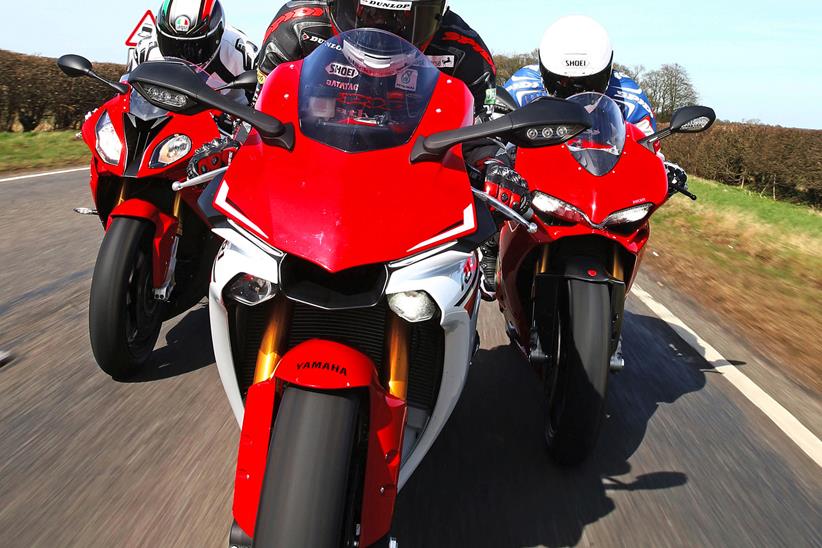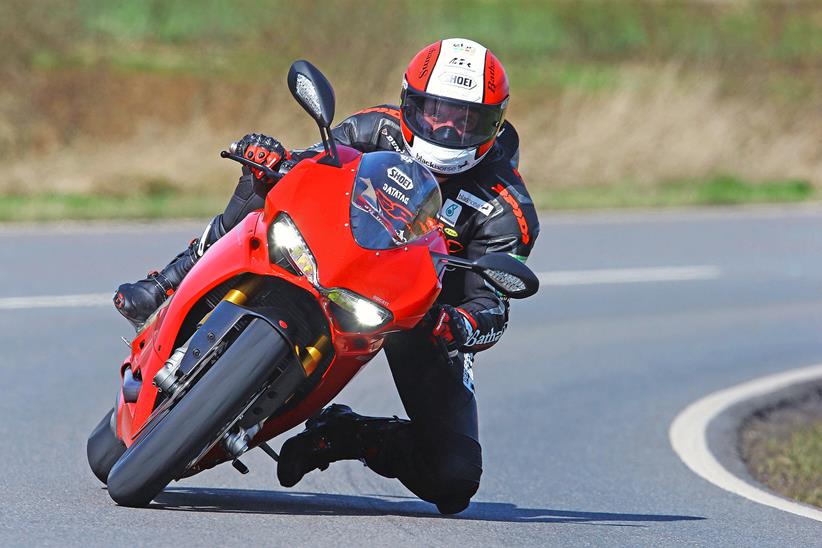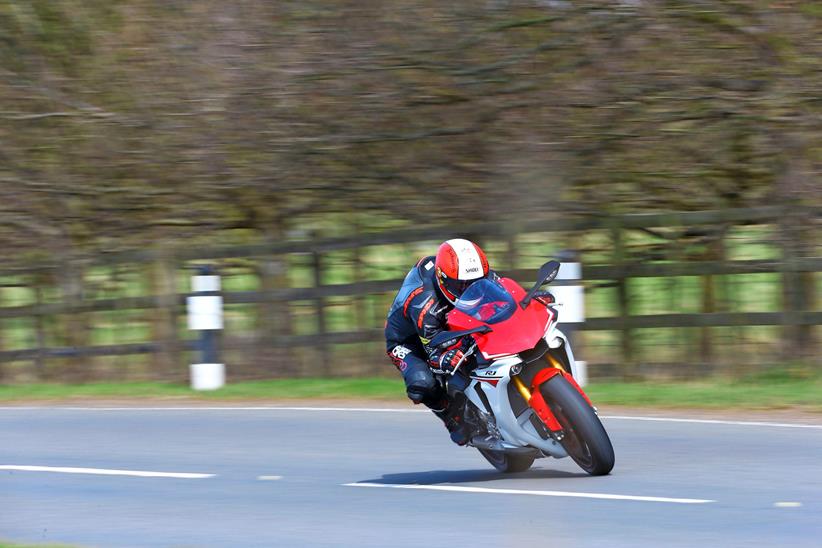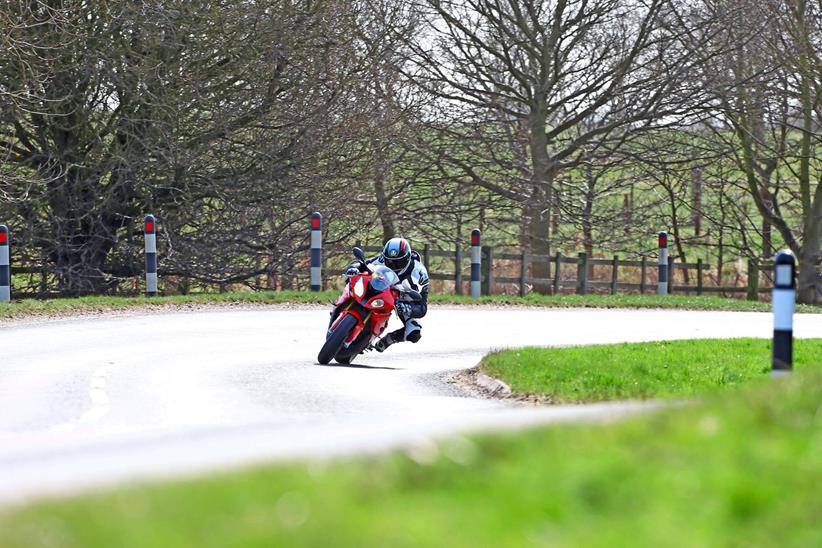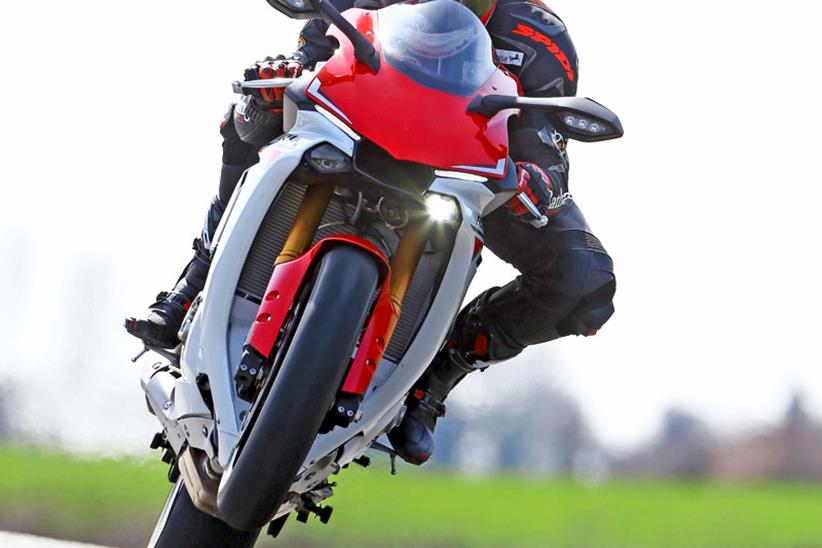Michael Rutter versus the 'too-fast-for-the-road' class of 2015
On the road, Yamaha’s new R1, BMW’s revised S1000RR and Ducati’s souped-up 1299 S are so off the scale it’s hard to say anything sensible about them. So it helps to have a man used to doing 200mph between the hedges to do the talking.
![]() oly Christ, I thought I was going to die!”
oly Christ, I thought I was going to die!”
When the man uttering the sentiment is one Michael Rutter Esq., whose CV of road racing achievements is longer than most people’s life story, you take notice. It must take something pretty hairy to widen the eyes of a 13-times NW200, eight-times Macau and four-times TT winner.
On this occasion, though, we’ve merely ridden five miles across town to fill up at a garage. Michael smiles. “There are usually fewer cars around when I’m on a bike,” he explains.
Rutter, myself and Johnny Mac brim the three red machines before heading off for a day tearing Lincolnshire a new one. As I pay for the fuel I look out over rows of chewing gum, and across at the forecourt where the Yamaha R1, Ducati 1299 S and BMW S1000RR are gathered round the pump, huddling in a conspiracy of outrageous performance.
I run through numbers in my noggin: the Yam is 190bhp, the BMW 196bhp, so too the Ducati. With a good launch they’ll hit 180mph from a standstill in just over half a mile. In top gear, they take less than 10 seconds to roll on from 40mph to 120mph. That is just nuts.
But all three are festooned with cutting-edge, race-derived electronic technology that makes such extreme performance a) possible and b) not just survivable, but an absolute hoot to use. Getting away with it has never been so hilariously, outrageously easy.
![]()
Eighteen years ago the scene would have included the original R1, perhaps Aprilia’s RSV Mille, or a Ducati 916; maybe a ZX-9R. Great bikes, thrillingly explosive in their day. But the new breed of electronically-enhanced litre sportsbikes quicken the pulse like never before, no matter how old and doddery we’re getting. You’re never too washed-up for a race rep, and they still reduce us to giggling kids. Although watching Johnny and Rutter clowning about with paper towels as they wait at the pumps, it’s not as if they need help…
We fire up in a supersonic thunder of mixed firing intervals, massive 90° V-twin detonations mingling with the V4-esque warble of Yamaha’s crossplane motor and the straight mechanical bark of BMW’s 180° inline four. Out of the garage, we fight through queues of crawling traffic to get to the interesting roads. But it gives us the chance to get an idea of the new R1 away from its natural, open road habitat.
“The Yam is a small bike with a big riding position,” says Johnny before we ride off. “It reminds me of the Aprilia RSV4. Nice big seat, bars are reasonable; I could go a long way on it. It looks like it’s going to be torture, but it’s not.”
He’s right. The Yamaha is small, but not ridiculously, 250 tiny. It’s R6-sized, which means it looks like it won’t fit when you eye it up warily from a distance, but as soon as you’re onboard it feels just about big enough. Compact, ready for action, but not daft.
‘A stunt kite in a gale’
And the front-end biased riding position of the previous R1, which seemed to plant the headstock directly below the rider’s groin and loaded wrists with lead, is gone. Instead the R1 now feels balanced at standstill, body weight spread evenly, and even more balanced on the move. The first impression is of featherweight and agile steering. I remember rolling out of the pitlane at Eastern Creek in Australia on the 2009 crossplane R1 and being immediately surprised at how much force it needed merely to roll the thing from side to side (a feeling that never entirely went away).
The new R1 is completely different. It flicks left to right and back like a Peter Powell stunt kite in a gale, warming my early morning brain as much as putting heat into the tyres. The chassis has an instant rightness that makes me smile, and give the other two on the BMW and Ducati a thumbs up.
The oncoming traffic clears for a moment, so I let a few of the R1’s demons slip loose. The motor spools up like a turbine for a micro-second, then eviscerates the nose-to-tail line of cars and lorries, turning them inside out and leaving them spinning, gutted, in the wake of the Yamaha’s howling, shattering pace. I mean, really: holy fuck, what an engine. What. An. Engine. For all the guff Yamaha made about the mechanicals inside the previous R1 being derived from Valentino Rossi’s M1, and how the crossplane crank produced ‘pure’ torque that felt intimately connected the throttle, that engine feels like a truck motor compared to this thing.
No word of a lie, as I ride along casually deploying its weapons-grade acceleration, the machine the Yam reminds me of most is Honda’s RC211V, the 990cc MotoGP tool I was lucky enough to ride back in 2005. That bike had been dialled back by HRC technicians from full race spec to a softer, journo-friendly 200-odd bhp. It has taken 10 years to get the same feeling of incomprehensible, but invincible, performance on the road. But here we are, and the Yamaha R1 definitely has it. It feels like the power curve is a near-vertical ramp, especially between 7000 and 9000rpm.
![]()
The new R1 motor is substantially narrower than the old bike’s, with a lighter crossplane crank, revised, lighter counterbalance shaft, titanium rods, wider bores and shorter stroke, finger rocker valve gear and redesigned head. This should amount to more revs, more power, sharper engine response and lighter steering.
And it does. The Yamaha romps through the early morning river of commuting tin boxes like a bionic eel weaving effortlessly upstream, driving relentlessly forward in a flood of quickshifting shortshifts.
Awesome though its engine is, the R1 is not flawless. The quickshifter is fine on upshifts, but coming the other way down the box is a bit hit and miss, especially with an insanely tall first gear – I often find myself trying to shift down into a gear below. Rutter has the same issue: “It’ll do over 100mph in first,” he points out. “This isn’t going to be much fun in hairpins. There’s a lot of engine braking, too, and it’s easy to lock the rear.”
‘Try it in mode three’
Throttle response needs fine judgement to avoid jerkiness. I’m not sure if it’s a fuelling thing; I reckon the actual grip is physically stiff to turn, as if the rubber is fouling the bar end (it isn’t) or a cable is trapped (it isn’t either). The S1000RR’s fly-by-wire grip turns like a lightly-sprung volume dial in comparison. Either way, I find myself using a combination of clutch and rear brake to smooth things out. We stop for a coffee and I mention the problem.
“What mode are you in?” asks Johnny Mac. Er, it says Mode 1 on the big colour screen. We used to call them clocks, but that’s no longer sufficient. Is it officially now a dash? A swarm of acronyms and pictograms is very cool but will anyone be admiring the brake pressure monitor when their eyeballs are glued to the visor?
“Try it in Mode 3,” suggests McAvoy. “It’s the same power and delivery, just with softer throttle response.” Rutter nods.
With no manual, we stab at buttons – a rocker switch system on the left bar, a scroll wheel on the right. Once you work it out, it’s fairly simple to master.
We hammer off again into the Lincolnshire Wolds. The throttle still feels stiff. But the roads are dry, the tarmac is warming up, and the R1 starts to deliver on its promise of A-road supremacy. It’s truly, madly, deeply sublime, pulling wheelies off crests with electronically-controlled accuracy, back end sucking into the tarmac and releasing grip in tiny, metered stages of slippage – and all the while with the droning, baleful moan of a bewitching powerplant. It’s sportsbike heaven. In fact R1 is so calm and collected at speed, it doesn’t feel significantly faster than the other two. But it gets where it’s going so much sooner than either of them that it must be. No wonder Rossi cuddles his M1 all the time. Surprised he doesn’t nip off with it for a quickie. It flatters your riding, inspires new confidence to go at it harder – not faster, as such, just smoother and better.
![]()
We swap bikes and I take the BMW S1000RR. Michael Rutter is raving about it: “It’s fucking beautiful. You feel like you could ride a million miles on it and then go racing with it without even thinking about it. Thank God for the heated grips early on though – without them I’d have said ‘Fuck it,’ and turned round and gone home.”
I covered 10,000 miles on the original S1000RR in 2010 and around 4000 on the tweaked 2012 model. I’ve also ridden this bike before, at the launch. So I know it’s going to feel amazing. It’s basically taken the cool bits of the old HP4 – semi-active suspension, enhanced electronics and braking, engine tweaks – and added them to the S1000RR package. Until the R1 was announced, it sounded unbeatable.
But after riding the Yamaha, the S1000RR – yes, I know this sounds crackers – feels large, doesn’t turn as sweetly; it’s more practical and road-oriented than the R1, a feeling backed up by heated grips, cruise control and the best quickshifter and autoblipper of the three. Rutter’s impressed: “You’d never think you’d need them on the road, but they’re just fantastic. Now I’ve tried it, I wouldn’t buy a bike without one.” Purists may mock, but this stuff is genuinely useful.
The BM also has a roomier riding position than the R1, with a longer reach to the bars. “The S1000RR is the most conventional, and feels like an evolution of previous inline four litre sportsbikes,” says McAvoy. “The R1 and the Ducati are doing something different mechanically, and have a more contemporary riding sports riding position.”
The BMW is noisy, too, with a lot of chain whine and howling inline four exhaust note. It sounds harsh against the musical purr of the Yamaha and the basso profondo of the Ducati – but the burbling from the collector box as unburned fuel ignites on the overrun is pure Group B rally car.
BMW: your frugal friend
As the big hand moves past midday, I realise that although the S1000RR doesn’t ignite quite the same intensity of seething passion as the Yam (and we’re talking fractions of a degree of trouser arousal), it’s a much better road bike. The engine is more tractable, with a bigger shunt off the bottom end and up to 7000rpm, the riding position is roomier, the fairing and screen are taller and keep more wind off, the handling is steadier and the motor is less inclined to land you laughing maniacally in front of a magistrate.
It’s also a lot less thirsty; both the R1 and the Ducati are perfectly capable of sucking petrol away at 25mpg on the road while the BM does nearer 40mpg for the same pace. It means the Beemer gets close to 150 miles on a tank while the other two are under 100. That’s a big difference – sod the money, it’s an extra pit stop even on a short run.
Ducati time. The 1299 Panigale S is basically a big-bored 1199 Panigale, with enhanced electronics and, on the S model, semi-active suspension.
Technically, to wrest this much power from a 90° V-twin without having to throw crankcases, gearboxes and internals at it with WSB regularity, is astonishing. Even more astonishing is how much difference there is between this bike and its predecessor.
The 1199 was a bastard of a handful at speed, especially away from a racetrack where bumps, cat’s eyes, potholes and white lines would blur the rider’s vision like sitting on a supercharged Kango hammer. It had plenty of performance, but the trick was getting to use it. Even quality ex-international racers struggled on track to match the lap times other bikes could comfortably set.
On the road, you couldn’t take the bike anywhere near full potential because it’d leap about like a beached mackerel trying to climb back into the sea.
The 1299 takes that zone of extreme behaviour and pushes it 30mph further away, then smoothes out the rest of the ride as if Claudio Domenicali himself is ironing out the wrinkles in the road before you get to them.
The engine feels more managed than the 1199; softer edges to the combustion blows, less driveline chatter, greater rev range flexibility and more forgiving suspension. Where the old bike would charge headlong, bars flapping and suspension bucking, the 1299 dips its tail and gets on with going fast. All three bikes are physical at speed. The R1 spends so much time with its front wheel hovering serenely a few inches off the ground you sometimes forget and only realise when you go to steer it and you can’t.
The BMW, physically larger than the R1, takes more muscle to thread it down a country road. And the Ducati has the most chassis movement, moving about beneath as if to remind you how fast you’re travelling. Neither is better nor worse; just different flavours of fantastical.
Even the 1299’s riding position feels different from the 1199 (although it’s apparently almost identical; the fairing nose is wider, screen taller and seat is comfier). It all adds up to a serious degree of usability; the 1299 Panigale S is a Ducati with manners even a committed four-cylinder fan can appreciate. This morning I was convinced I need an R1 in my life, by midday the BMW was the only bike for me… but now, as the shadows lengthen, it’s the Panigale I can see in my garage.
As the day draws to a close, we cruise back to the PB office. At a leisurely pace, the BMW shines with its competence and user-friendliness – until I jump back on the Ducati and it becomes my favourite again, with its lumping great character. Then I finish on the R1 and decide no, that’s the engine I’ll be dreaming about tonight.
Verdict? We’ll take the red one
The sun is setting, so we park up to pick a winner. It’s impossible of course. Unlike lap times, dynos and top speeds, on the road with bikes like the R1, S1000RR and Panigale there are no empirical absolutes. It’s all about opinions and preferences. Obviously all three operate at a stratospheric level of performance, with handling and electronics to match. if you’ve got the money all three of these bikes unlock an amazing world. But within that there are differences and the bikes have slightly different strengths and weaknesses. It’s all about what you want from a bike. So…
If you want to feel like a racer
The R1 is the race bike of the bunch; the lightest-feeling and the most aggressive. You’d choose it if you wanted to live on a track and replicate the feats of Rossi and Lorenzo. But the engine is perfectly atuned to road riding, too, and the handling is brilliant. It’s as good as Japan gets in 2015.
![]()
If you want to feel amazed
And amazing, the Ducati is the best-looking, surprisingly civilised but still boomingly domineering. It’s a highly visible, swaggering statement of speed – but now packaged with more finesse, and genuinely fun instead of terrifying. But it is a huge amount of money – even the base model is £17k and this S model is almost £21k.
![]()
If you want the most complete bike
The S1000RR is the most refined and civilised, with the most concessions to the niceties of life. It has huge power, great handling and an easy-to-expolit manner than makes you get the most of of it soonest. But it’s also the least engaging, emotionally – the one motorcycle here that stirs the soul slightly less. ![]()
 But, ultimately, Michael Rutter and we agree. We’d have the red one…
But, ultimately, Michael Rutter and we agree. We’d have the red one…
Words: Simon Hargreaves Pics: Chippy Wood
![]()
